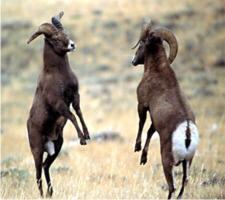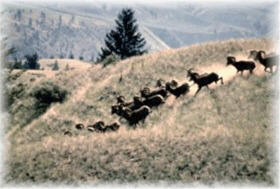Lifestyle
Bighorn sheep migrate in herds. The route in which the herd travels is laid
out for them by the last generation of rams. Each bighorn, aware of its role in the herd,
follows his elders with obedience. A ram's horns are symbolic to its dominance
over or under other rams. Dominance arises by having the largest horns in the
group. If disobedience is met or if a ram is challenged for dominance, a battle
occurs. A ram can be challenged for dominance anytime during the year. Fights
occur only between males of the same size, leaving the biggest males
unchallenged. Fights are not done for sport. They only take place when proving
dominance within a herd or when vying for a female. Fights mainly occur between average size rams,
usually 5-7 years of age.![]()
 The
battle between bighorns is intense. The two males rush at each other
at a combined speed of 40mph, lower their heads, and clash with a
force of 2400 pounds! The impact causes their hind legs to lift off the ground
and the sound to echo for over a mile. They may charge one another on their hind
legs or on all fours. The thickness of the skull and density of their
horns, prevents serious brain damage from occurring. The osteocytes of the
skull
are spaced apart and act as a cushion for the blow. The endurance of these
magnificent animals is parallel only to that of a machine. These battles can
last for over 20 hours,
stopping only to feed or regain comprehension. A male loses when he walks away
from the fight or simply does not charge, but is not outcast. Instead, he must accept his role amongst the herd.
The
battle between bighorns is intense. The two males rush at each other
at a combined speed of 40mph, lower their heads, and clash with a
force of 2400 pounds! The impact causes their hind legs to lift off the ground
and the sound to echo for over a mile. They may charge one another on their hind
legs or on all fours. The thickness of the skull and density of their
horns, prevents serious brain damage from occurring. The osteocytes of the
skull
are spaced apart and act as a cushion for the blow. The endurance of these
magnificent animals is parallel only to that of a machine. These battles can
last for over 20 hours,
stopping only to feed or regain comprehension. A male loses when he walks away
from the fight or simply does not charge, but is not outcast. Instead, he must accept his role amongst the herd.![]()
However, fights for females are much more brutal. If a male attempts to court a female and is challenged, he must accept. During battle, if a male is knocked down, the other might rush at him again, easily breaking ribs and legs. Also, a third male may charge the torso of a battling ram. This provides opportunity for yet another ram to come in and court the female. The viciousness of this fight echoes throughout the valleys and mountains.
